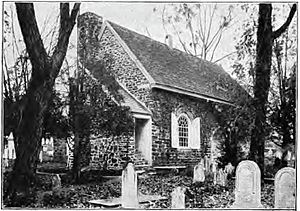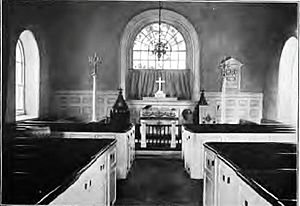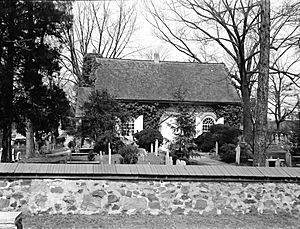St. David's Episcopal Church (Radnor, Pennsylvania) facts for kids
|
St. David's Church and Graveyard
|
|
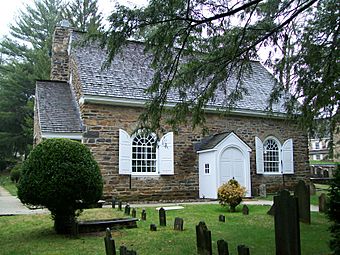
St. David's, April 2009
|
|
| Location | 763 South Valley Forge Road, Radnor Township, Pennsylvania, U.S. |
|---|---|
| Area | 1 acre (0.40 ha) |
| Built | 1715 |
| NRHP reference No. | 78002394 |
Quick facts for kids Significant dates |
|
| Added to NRHP | September 20, 1978 |
St. David's Episcopal Church, also called St. David's at Radnor, is a very old church in Radnor Township, Pennsylvania. It's part of the Episcopal Church. The church property includes the original church building from 1715, a chapel, offices, a school, and a large cemetery. This special place sits across the borders of three different townships and two counties!
St. David's was started around 1700 by Welsh settlers in a part of Pennsylvania known as the Welsh Tract. It has grown a lot over the years. Today, it's the biggest church in the Episcopal Diocese of Pennsylvania, with about 3,000 members. The first church building and its cemetery were added to the National Register of Historic Places in 1978. This means they are important historical sites.
Contents
History of St. David's Church
How St. David's Began
After the Welsh Tract was set up in the colony of Pennsylvania, many people from Wales moved there. Most were Quakers, but other Welsh people came too. They liked Pennsylvania because it offered religious toleration. This meant they could practice their faith freely and even speak their own language.
Life on the frontier was tough, and it was hard for people to practice their religion. There often weren't churches or priests. So, a group in London called the Society for the Propagation of the Gospel in Foreign Parts sent a Welsh Anglican priest, Rev. Evan Evans, to help. He started holding church services in people's homes in 1700. One of these homes was William Davis's house in Radnor.
Records from 1700 mention a church made of logs. This log church was also meant to be a safe place if Native Americans attacked. In 1708, a writer named John Oldmixon wrote that Radnor had about 50 families and a group of Church of England members, but no official minister.
After Rev. Evans left, the Welsh-speaking Anglicans in Radnor asked for more Welsh prayer books and Bibles. They also really wanted another Welsh-speaking priest. It took a while, but ten years later, they met their new leader. The church members decided to build a beautiful stone church. They named it after Saint David, the patron saint of Wales.
The first stone for the new church was laid on May 9, 1715. It was a special moment because other religious leaders helped, showing they could work together. One helper was Pastor Sandel from Old Swedes Church in Philadelphia. The church didn't even have a proper floor until 1765! The original stone church is still standing today. It can seat 100 people in old-style box pews. The organ inside was built in 1952.
Early priests, like Rev. John Clubb and Rev. Robert Weyman, were paid by the Society for the Propagation of the Gospel. They shared their time between St. David's and Old Trinity Church, which was about 20 miles away.
Revolutionary War and Early America
When the American Revolution began, people in the colonies started to feel angry at the Church of England. This church was loyal to the King of England. A strong leader against the King was Anthony Wayne, a lifelong member of St. David's. He later became a major general in the American army.
The church's priest, Rev. William Currie, had sworn loyalty to the King. So, he resigned his job. The church didn't have an official priest for 12 years. During the war, no services were held in the church building. The church even provided shelter for soldiers from both sides. Continental Army soldiers (American soldiers) took the lead from the church windows to make bullets! After the nearby Battle of Brandywine, sixteen British soldiers were buried in the cemetery at St. David's.
Even though St. David's left the Church of England, it stayed part of the larger Anglican Communion. The church was represented at the first big meeting of the Protestant Episcopal Church of the United States in 1784, after the peace treaty was signed.
The church officially became a legal organization in August 1792. A church school started in 1820. The first confirmation services (a special church ceremony) were led by Bishop William White. He became the first leader of the Episcopal Church. The first new building added to the church property was the stone "Old Rectory" in 1844.
Growth and Changes in Modern Times
After the "main line" railroad was built in 1832, the area around St. David's started to change quickly. The railroad built local stations and offered frequent train service. One of these stations was named St. Davids after the church. A community grew up around this station. As people from Philadelphia started to live outside the city in the late 1800s, the church's members became more like suburban residents.
As more people joined the church, it needed more space. A parish house (office building) with school rooms was built in 1924 and made bigger in 1950. The church kept growing, and people debated whether to build a new, larger church or keep the old one small. They decided to build a new, much bigger worship building in 1956.
On October 13, 1947, a special Pennsylvania Historical Marker was placed at St. David's Church. This marker shows how important the site is to history. The old church from 1715 and its cemetery were officially added to the National Register of Historic Places on September 20, 1978.
A separate building for Sunday school classes was built in 1965. That year, the church celebrated its 250th anniversary! The Bishop of St. David's from Wales even came to the service. This building is called the Knewstub Building, named after a former priest of the church.
The new chapel built in 1956 became too small after 50 years. So, a new, even larger chapel was built next to it in 2006. This new chapel can seat 650 people. A large organ was installed in 2007. The old chapel is now called St. David's Hall. It's used for receptions after services and other church events. It also connects the new chapel to the church offices.
The church property is unique because it sits where three different townships and two counties meet. The old church building and a small part of the graveyard are in Newtown Township, Delaware County. The chapel and offices are in Radnor Township, Delaware County. Most of the graveyard is in Easttown Township, Chester County.
Longfellow's Poem
In March 1880, the famous poet Henry Wadsworth Longfellow visited St. David's. He was touched by how peaceful and quiet "this little church among its graves" was. He wrote a poem about it called "Old St. David's at Radnor." It was published later that year in his book Ultima Thule. The poem mentions another poet, Welshman George Herbert, and his small church in Bemerton.
Historic Buildings
The "old" church building, built in 1715, was changed and added to many times over the years. These changes included moving the altar, adding a staircase to the choir loft, and building a room for the clergy. A shed for horses was built in 1850 and made bigger in 1871, but it has since been taken down.
These historic buildings were carefully recorded by the Historic American Buildings Survey. Many photographs were also taken to preserve their history.
Graveyard and Notable Burials
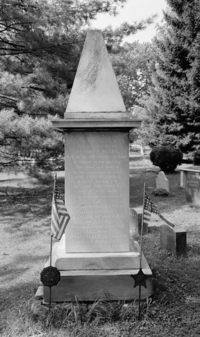
The graveyard at St. David's is the final resting place for many interesting people. Here are a few:
- William W. Atterbury (1866–1935), a general in World War I and president of the Pennsylvania Railroad.
- Rose Bampton (1907–2007), a famous opera singer.
- George W. Pepper (1867–1961), a U.S. Senator.
- Helen Hope Montgomery Scott (1904–1995), a well-known socialite and helper of charities.
- Edward Lowber Stokes (1880–1964), a U.S. Congressman.
- Anthony Wayne (1745–1796), a Brigadier General during the American Revolution.
- R. Norris Williams (1891–1968), a professional tennis player and Olympic athlete.
The grave of American Revolutionary War General Anthony Wayne at St. David's is one of two places where he is buried. He died on his way back to Pennsylvania from a military post. He was first buried at Fort Presque Isle, Pennsylvania. Later, in 1809, his son, Isaac Wayne, moved his body. The bones were then brought to the family plot in the St. David's graveyard. On June 5, 1811, a group called The Pennsylvania State Society of the Cincinnati placed a monument in the cemetery to honor Anthony Wayne.
Rectors of St. David's
Many missionaries and rectors (church leaders) have served St. David's over the centuries. Here are some of them and their years of service:
- Evan Evans, D.D., 1700–1704
- John Clubb, around 1707–1715
- Evan Evans, D.D., 1716–1718
- John Humphreys, 1718–1719
- Robert Weyman, 1719–1730
- Richard Backhouse, 1730–1732
- Griffith Hughes, 1732–1736
- William Currie 1737–1776 (officially), 1776–1785 (unofficially)
- Slator Clay, 1786–1821
- Samuel Crawford Brinckle, 1818–1832
- Simon Wilmer, 1832–1833
- William Henry Rees, D.D., 1833–1838
- Willie Peck, 1838–1845
- Breed Batcheller, 1845–1847
- Thomas Greene Allen, 1847–1848
- John Albemarle Childs, D.D., 1848–1850
- Henry Brown, 1851–1855
- Richardson Graham, 1856–1861
- Thomas Green Clemson, Jr., 1861–1866
- William Frederick Halsey, 1866–1882
- George Alexander Keller, 1882–1902
- James Hart Lamb, D.D., 1902–1918
- William Cunningham Rodgers, D.D., 1919–1922
- Crosswell McBee, D.D., 1922–1945
- John Cecil Knewstub, 1945–1966
- Richard Walton Hess, 1967–1983
- Stephen Kent Jacobson, D.Min., 1984–1996
- W. Frank Allen, 1997–2023




